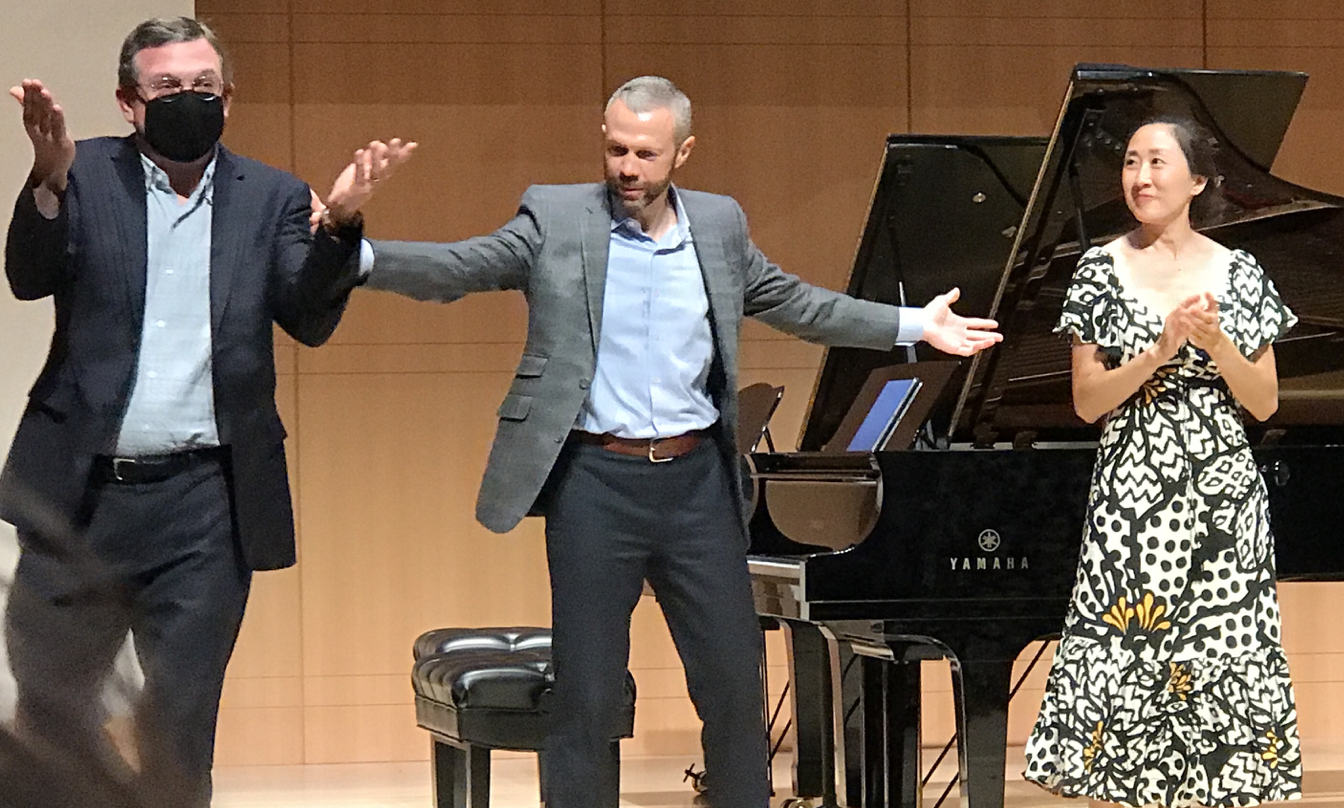|
Symphony
FROM THE NEW WORLD TO THE OLD WORLD
by Peter Lert
Saturday, June 14, 2025
Chamber
MC2 DUO RECITAL CLOSES 222'S SEASON
by Terry McNeill
Saturday, June 14, 2025
Choral and Vocal
CANTIAMO SONOMA'S LUSCIOUS A CAPELLA SINGING IN SEASON ENDING CONCERT
by Pamela Hicks Gailey
Sunday, June 8, 2025
Symphony
SRS SEASON ENDS WITH RESOUNDING TA-TA-TA-BANG
by Terry McNeill
Sunday, June 1, 2025
Symphony
YOUTHFUL VIRTUOSITY ON DISPLAY AT USO'S MAY CONCERTS
by Peter Lert
Saturday, May 17, 2025
Symphony
MYSTICAL PLANETS AND LIVELY GERSHWIN ORTIZ AT FINAL SRS CONCERT
by Peter Lert
Sunday, May 4, 2025
Symphony
VSO'S CONCERT MUSIC OF TIME, MUSIC OF PLACE
by Peter Lert
Sunday, April 27, 2025
VOCAL ELEGANCE AND FIRE AT THE 222'S RECITAL APRIL 26
by Pamela Hicks Gailey
Saturday, April 26, 2025
CANTIAMO SONOMA SINGS AN INSPIRED GOOD FRIDAY MOZART REQUIEM CONCERT
by Pamela Hicks Gailey
Friday, April 18, 2025
DRAMATIC SHOSTAKOVICH SYMPHONY CLOSES PHILHARMONIC'S 25TH SEASON
by Terry McNeill
Sunday, April 13, 2025
|
 |
 l to r: T. Cabaniss, M. and J. Shinn |
ONE PIANO, TWO PIANO, THREE PIANO, FORE
by Terry McNeill
Thursday, July 29, 2021
Schroeder Hall was nearly full July 29 for the final pianoSonoma concert of their season, and presumably the draw and highlight for many of the 150 attending was Bach’s Concerto for Four Pianos. And that performance was probably going to be a North Bay premiere.
However, it wasn’t the highlight, that honor going to another premiere, the world premiere of Thomas Cabaniss’ Suite for Two Pianos, “Trinity Pass.” Each of the four sections was preceded by a segment of the composer’s own poetry, read at stage left by Kara Dugan, and played by pianists Jessica and Michael Shinn. The initial movement “Swoop” was tonal, as was the work throughout, with occasional Lisztian rumblings. “Brooms” had a faintly oriental character with busy fusillades of notes from both instruments, a Forte march and an occasional Fermata respite.
The more lyrical “Games of Catch” came next, played with judicious tempos, odd echoes of minimalist music, and exuberant sections combining a mélange of compositional ideas. The finale (“Cathedral Ceiling”) had a slow introduction that jumped into a toccata part, slightly heroic in places, with several short points of rest in the score. The off-beat majestic accents were telling, sometimes dissonant, and the Shinns were equal partners in the unique celebration of sound.
“Trinity Pass” was a champagne orgy of color in rich piano sound, and at the finish of loud tremolos from both instruments bravos broke forth, and Mr. Cabaniss was called from the back of the hall to accept an ovation.
What could safely follow such a dynamic opening? An atmospheric Takemitsu work, Rain Tree Sketch, performed by pianist Christine Wu, and she had recently splendidly played on the same stage Chopin’s Op. 17 Mazurkas. Rain Tree was written memory of Messiaen, and there were references to the French master’s music, especially the 1944 Vingt Regards sur l’Enfant Jésus. Ms. Wu’s playing caught the languorous nature of the music and used a lot of airy pedal point.
Three sections of Saint-Saëns’ Carnaval of the Animals featured cellist Anita Graef joining the Shinns, the extravagant sounds of “Kangaroos” and “Wild Donkeys” preceding the iconic “The Swan," with the cello joining in. Ms. Graef’s intonation and careful phrasing were good, but her lightweight projection was often covered by the pianos. Swan never fails with an audience, and did not here.
Milhaud’s 1937 Scaramouche for two pianos is another crowd pleaser, and the composer was for decades well known in the SF Bay area at Mills College, and for his three-hour plus Opera “Christophe Colomb” and a remark that Brahms was an overrated composer. Ms. Wu and Peter Dugan gave the work a rollicking ride, loud, pushing the tempos with a brittle blur of sound that perhaps is appropriate. The samba at the end was played as a brilliant dance.
What happened to the seminal Bach, the A Minor Concerto (BWV 1065)? It closed the program, and featured four pianists (the Shinns, Ms. Wu and Mr. Dugan) and four string players: cellists Ms. Graef and Michael Dahlberg; Julian Graef (viola) and violinist Doori Na. I can only recall one long ago multi piano concerto performance in Sonoma County, with Norma and Corrick Brown joining San Francisco virtuoso William Corbett-Jones and the Santa Rosa Symphony, but that was Mozart, the K. 242 Concerto. Corrick conducted from the piano, but here there was no conductor and it was clear from the fast opening tempo that the concert Yamahas would overwhelm the string players. They were seen with busy bows but not heard.
It was nearly 13 minutes of sonorous counterpoint, the outer movements often indistinct at instrument entries, and leavened by the wonderful Largo that at times was played without any strings but with choice modulations. The tempo in the concluding Allegro looked like it would push the music off the rails, but it never did, and finished with a roar of applause in a standing ovation.
Mr. Shinn mentioned that pianoSonoma would return to the Green Music Center in 2022, and thanked the Green’s staff and Executive Director Jacob Yarrow for stellar support. In his plentiful appreciation remarks he forgot to mention the hard work of Festival piano technicians, Will Reed (primo) and his colleague Larry Lobel (segundo) that crafted four instruments into a mighty one for Bach’s enthralling concerto.
|

